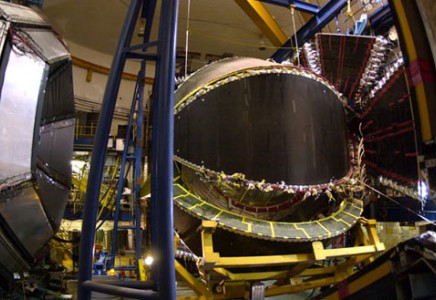Jefferson Lab Science

The CEBAF Large Acceptance Spectrometer, or CLAS, in Jefferson Lab's Experimental Hall B was used to measure electrons during the experiment.
Additional Links
Ordinarily, getting two for the price of one is a great deal. But in some experiments that study protons, that great deal may be confounding the results. Now, scientists are months away from clearing up the confusion, thanks to a tricky measurement made with mixed beams of matter and anti-matter.
The two-for-one problem is spawned by a popular method used to study protons. According to Larry Weinstein, a professor at Old Dominion University, the method involves measuring how electrons and protons interact via the different parts of the electromagnetic force. Disentangling the electric from the magnetic gives clues on how the proton's building blocks, quarks, are distributed inside the proton.
To conduct these experiments, scientists pelt protons with spinning electrons, and then observe how the particles interact.
"If the electron scatters forward, the interaction is going to be both electric and magnetic," Weinstein explains. "If the electron hits and bounces back, the spin of the electron almost certainly flips, and the interaction is only magnetic."
Scientists measure the electrons as they scatter in many different directions and calculate what percentage of each came from the electric and the magnetic parts of the force. The result can be used to map out the location of charge, supplied by the quarks, inside the proton.
The confounding part comes in when the electrons don't interact in the prescribed way. In the above, for instance, it's assumed that the electron interacts with a proton by spitting out a single virtual photon as they approach. A virtual photon is the name that physicists give to packets of energy that electrons bestow upon protons as they bang into them.
However, similar processes can interfere with this seemingly straightforward measurement. For instance, the electron may spit out two virtual photons. This makes the interaction more complicated. Theorists have calculated that this two-photon process may beef up the signal that physicists measure, confounding their results.
"What I really want to know is the contribution of this 'two photon exchange' to electron scattering," Weinstein says.
In the winter of 2010, Weinstein and a team of more than 100 scientists set out to measure just how much this process adds to their measurements. Their experiment was titled E04-116: Beyond the Born Approximation: A Precise Comparison of Positron-Proton and Electron-Proton Elastic Scattering in CLAS. It yielded the first-ever mixed matter/anti-matter beam measurement of the proton. Weinstein recently presented the preliminary results to his colleagues.
"Right now, all we can really say is, it's a tough experiment, and it really looks like we pulled it off, but we can't say anything for sure yet," Weinstein says.
If successful, the experiment could help clear up a discrepancy between two different methods of measuring how quarks are distributed inside the proton. In the second method, spinning electrons are bounced off of protons, and the spin of the protons are measured after the collision. Results from these two, different methods disagree by as much as a factor of three. It's expected that two-photon exchange is adding to the original method of measurement, contributing to this discrepancy. A precise measurement of the process could confirm that theory. This problem is so important that two other groups, the VEPP-3 collaboration at Novosibirsk and the OLYMPUS collaboration at DESY, are working to solve it.
He says the collaboration is now working to put together all of their data into a final package that can then be used to help clean up prior results.
"If this explanation is not correct, then we have some serious head scratching to do, because this is the preferred explanation. There isn't a second best," Weinstein adds.
You can read more about this research in the DOE Pulse: http://www.ornl.gov/info/news/pulse/no327/feature.shtml

